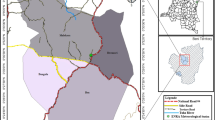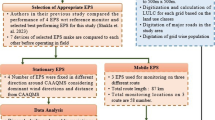Abstract
The outdoor climate condition is one of the deterministic factors influencing building energy consumption. Building performance simulation (BPS) tools usually adopt typical meteorological year (TMY) as the outdoor climate input. Despite that many scholars and institutes have developed TMY datasets, these datasets are usually based on distinct data sources and methods. Considering the increase of international cooperation construction projects, compatible TMY dataset for different countries is in urgent need. This paper presents a global typical meteorological year (TMY) database covering 38,947 stations worldwide based on the fifth-generation atmospheric reanalysis product released by the European Center (ERA5). The data is created with Chinese Standard Weather Database (CSWD) method to reflect the average level of historical weather. The dataset is saved in a 55 GB database of compressed CSV files and a website is established where users can download their required TMY data for certain cities according to the longitude and latitude information. A systematic validation is conducted to confirm the feasibility of ERA5 as data source and validity of generated TMY data. This TMY-ERA5 dataset is fundamental and essential in building system designs of international construction projects, building performance simulation, especially for some countries lacking ground meteorological stations or missing meteorological year data in the building sector. It can be used as references for other meteorological climate studies.
Similar content being viewed by others
Abbreviations
- AMY:
-
annual meteorological year
- BPS:
-
building performance simulation
- CDD:
-
cooling degree day
- CMA:
-
China Meteorological Administration
- CSWD:
-
Chinese standard weather database
- ECMWF:
-
European Center for Medium-Range Weather Forecasts
- ERA5:
-
the fifth generation ECMWF atmospheric reanalysis of the global climate
- HDD:
-
heating degree day
- IFS:
-
integrated forecasting system
- RMSE:
-
root mean square error
- TMY:
-
typical meteorological year
References
Abatzoglou JT (2013). Development of gridded surface meteorological data for ecological applications and modelling. International Journal of Climatology, 33: 121–131.
Berardi U, Jafarpur P (2020). Assessing the impact of climate change on building heating and cooling energy demand in Canada. Renewable and Sustainable Energy Reviews, 121: 109681.
Bhatnagar M, Mathur J, Garg V (2018). Determining base temperature for heating and cooling degree-days for India. Journal of Building Engineering, 18: 270–280.
Bonavita M, Hólm E, Isaksen L, et al. (2016). The evolution of the ECMWF hybrid data assimilation system. Quarterly Journal of the Royal Meteorological Society, 142: 287–303.
Chan ALS, Chow TT, Fong SKF, et al. (2006). Generation of a typical meteorological year for Hong Kong. Energy Conversion and Management, 47: 87–96.
Chen Z, Yu B, Li Y, et al. (2022). Assessing the potential and utilization of solar energy at the building-scale in Shanghai. Sustainable Cities and Society, 82: 103917.
CIBSE T (2006). Degree-days: Theory and application. London: The Chartered Institution of Building Services Engineers.
Crawley D, Pedersen C, Lawrie L, et al. (2000). EnergyPlus: energy simulation program. Ashrae Journal, 42: 49–56.
Cui Y, Yan D, Hong T, et al. (2017). Comparison of typical year and multiyear building simulations using a 55-year actual weather data set from China. Applied Energy, 195: 890–904.
Dong B, Widjaja R, Wu W, et al. (2021). Review of onsite temperature and solar forecasting models to enable better building design and operations. Building Simulation, 14: 885–907.
Elangovan R, Kumar A, Alur R (2017). Thermal performance of building envelops. In: Abraham MA (ed), Encyclopedia of Sustainable Technologies. Oxford: Elsevier. pp. 169–188.
Festa R, Ratto CF (1993). Proposal of a numerical procedure to select Reference Years. Solar Energy, 50: 9–17.
Finkelstein JM, Schafer RE (1971). Improved goodness-of-fit tests. Biometrika, 58: 641–645.
Gelaro R, McCarty W, Suárez MJ, et al. (2017). The modern-era retrospective analysis for research and applications, version 2 (MERRA-2). Journal of Climate, 30: 5419–5454.
Gil Ruiz SA, Barriga JEC, Martínez JA (2021). Wind power assessment in the Caribbean region of Colombia, using ten-minute wind observations and ERA5 data. Renewable Energy, 172: 158–176.
Gualtieri G (2021). Reliability of ERA5 reanalysis data for wind resource assessment: A comparison against tall towers. Energies, 14: 4169.
Hall IJ, Prairie RR, Anderson HE, et al. (1978). Generation of typical reference years for 26 SOLMET stations. Saudia Laboratories Report SAND, Albuquerque, NM, USA.
Haq EU, Lyu X, Jia Y, et al. (2020). Forecasting household electric appliances consumption and peak demand based on hybrid machine learning approach. Energy Reports, 6: 1099–1105.
Harada Y, Kamahori H, Kobayashi C, et al. (2016). The JRA-55 reanalysis: Representation of atmospheric circulation and climate variability. Journal of the Meteorological Society of Japan Ser II, 94: 269–302.
He X (2020). DataHub, OpenGMS, China Meteorological Data Service Centre. Available at https://geomodeling.njnu.edu.cn/dataHub/f27d3edc-b6af-4d00-a7c3-5f58331ee116.
Herrera M, Natarajan S, Coley DA, et al. (2017). A review of current and future weather data for building simulation. Building Services Engineering Research and Technology, 38: 602–627.
Hersbach H, Bell B, Berrisford P, et al. (2020). The ERA5 global reanalysis. Quarterly Journal of the Royal Meteorological Society, 146: 1999–2049.
Huang YJ, Crawley DB (1996). Does it Matter Which Weather Data You Use in Energy Simulations? In: Proceedings of 1996 ACEEE Summer Study on Energy Efficiency in Buildings, Pacific Grove, CA, USA.
Huang YJ, Su FP, Seo DP, et al. (2014). Development of 3012 IWEC2 weather files for international locations (RP-1477). ASHRAE Transactions, 120(1): 340–355.
Hu S, Zhang Y, Yang Z, et al. (2022). Challenges and opportunities for carbon neutrality in China’s building sector—Modelling and data. Building Simulation, 15: 1899–1921.
Huo X, Yang L, Li DHW, et al. (2022). Impact of climate change on outdoor design conditions and implications to peak loads. Building Simulation, 15: 2051–2065.
IEA (2019). World Energy Balances 2019. International Energy Agency.
Isaac M, van Vuuren DP (2009). Modeling global residential sector energy demand for heating and air conditioning in the context of climate change. Energy Policy, 37: 507–521.
Jiang Q, Li W, Fan Z, et al. (2021). Evaluation of the ERA5 reanalysis precipitation dataset over Chinese mainland. Journal of Hydrology, 595: 125660.
Jiao D, Xu N, Yang F, et al. (2021). Evaluation of spatial-temporal variation performance of ERA5 precipitation data in China. Scientific Reports, 11: 17956.
Kalogirou SA (2003). Generation of typical meteorological year (TMY-2) for Nicosia, Cyprus. Renewable Energy, 28: 2317–2334.
Kalogirou SA (2012). Solar thermal systems. In: Sayigh A (ed), Comprehensive Renewable Energy. Amsterdam: Elsevier.
Lawrimore J, Menne M, Gleason B, et al. (2011). Global Historical Climatology Network — Monthly (GHCN-M), Version 3. In: Information. NNCfE (ed).
McKinley S, Levine M (1998). Cubic spline interpolation. College of the Redwoods, 45: 1049–1060.
Myers DR (2012). Solar radiation resource assessment for renewable energy conversion. In: Sayigh A (ed), Comprehensive Renewable Energy. Amsterdam: Elsevier.
Neto AH, Durante LC, Callejas IJA, et al. (2022). The challenges on operating a zero net energy building facing global warming conditions. Building Simulation, 15: 435–451.
NCD (1981). Typical Meteorological Year User’s Manual (TD-9734) Hourly Solar Radiation—Surface Meteorological Observations. NCDC Asheville, NC, USA.
Petri Y, Caldeira K (2015). Impacts of global warming on residential heating and cooling degree-days in the United States. Scientific Reports, 5: 12427.
Rahman IA, Dewsbury J (2007). Selection of typical weather data (test reference years) for Subang, Malaysia. Building and Environment, 42: 3636–3641.
Ren Z, Tang Z, James M (2021). Typical meteorological year weather files User Guide. Australia’s National Science Agency.
Rienecker MM, Suarez MJ, Gelaro R, et al. (2011). MERRA: NASA’s modern-era retrospective analysis for research and applications. Journal of Climate, 24: 3624–3648.
Sivak M (2008). Where to live in the United States: combined energy demand for heating and cooling in the 50 largest metropolitan areas. Cities, 25: 396–398.
Skeiker K, Ghani BA (2009). A software tool for the creation of a typical meteorological year. Renewable Energy, 34: 544–554.
Song F, Zhu Q, Wu R, et al. (2007). Meteorological data set for building thermal environment analysis of China. In: Proceedings of the 10th International IBPSA Building Simulation Conferences, Beijing, China.
Soukissian TH, Karathanasi FE, Zaragkas DK (2021). Exploiting offshore wind and solar resources in the Mediterranean using ERA5 reanalysis data. Energy Conversion and Management, 237: 114092.
Sykes A (1990). Macro projects: Status, prospects, and the need for international cooperation. Technology in Society, 12: 157–172.
Tarek M, Brissette FP, Arsenault R (2020). Evaluation of the ERA5 reanalysis as a potential reference dataset for hydrological modelling over North America. Hydrology and Earth System Sciences, 24: 2527–2544.
Thom EC (1958). Cooling degree-days. US Department of Commerce, Weather Bureau.
Urraca R, Huld T, Gracia-Amillo A, et al. (2018). Evaluation of global horizontal irradiance estimates from ERA5 and COSMO-REA6 reanalyses using ground and satellite-based data. Solar Energy, 164: 339–354.
Van De Giesen N, Hut R, Andreini M, et al. (2013). Trans-African Hydro-Meteorological Observatory (TAHMO): A network to monitor weather, water, and climate in Africa. AGU Fall Meeting Abstracts. H52C-04.
Wang R, Lu S, Zhai X, et al. (2022). The energy performance and passive survivability of high thermal insulation buildings in future climate scenarios. Building Simulation, 15: 1209–1225.
Wilcox S, Marion W (2008). Users manual for TMY3 data sets. National Renewable Energy Laboratory, USA.
William M, Urban K (1996). User’s Manual for TMY2S. National Renewable Energy Laboratory, USA.
Yan D, O’Brien W, Hong T, et al. (2015). Occupant behavior modeling for building performance simulation: Current state and future challenges. Energy and Buildings, 107: 264–278.
Yan D, Zhou X, An J, et al. (2022). DeST 3.0: A new-generation building performance simulation platform. Building Simulation, 15: 1849–1868.
Zhang G, Wu H, Liu J, et al. (2022). Dynamic performance and energy efficiency of reflective and insulative composite coating on building exterior wall. Building Simulation, https://doi.org/10.1007/s12273-022-0932-x
Zhou X, Lu Y, Hu S, et al. (2023). New perspectives on temporal changes in occupancy characteristics of residential buildings. Journal of Building Engineering, 64: 105590.
Acknowledgements
This study was supported by the National Natural Science Foundation of China (No. 52225801) and Beijing Municipal Natural Science Foundation of China (No. 8222019).
Author information
Authors and Affiliations
Contributions
Yi Wu: methodology, data curation, writing, and original draft. Jingjing An: methodology and conceptualization. Chenxi Gui: methodology and data curation. Chan Xiao: investigation and data resources. Da Yan: supervision, conceptualization, and methodology.
Corresponding author
Additional information
Declaration of competing interest
The authors have no competing interests to declare that are relevant to the content of this article.
Rights and permissions
About this article
Cite this article
Wu, Y., An, J., Gui, C. et al. A global typical meteorological year (TMY) database on ERA5 dataset. Build. Simul. 16, 1013–1026 (2023). https://doi.org/10.1007/s12273-023-1015-3
Received:
Revised:
Accepted:
Published:
Issue Date:
DOI: https://doi.org/10.1007/s12273-023-1015-3




